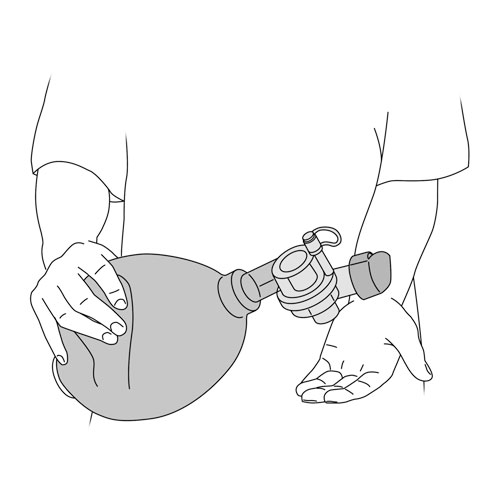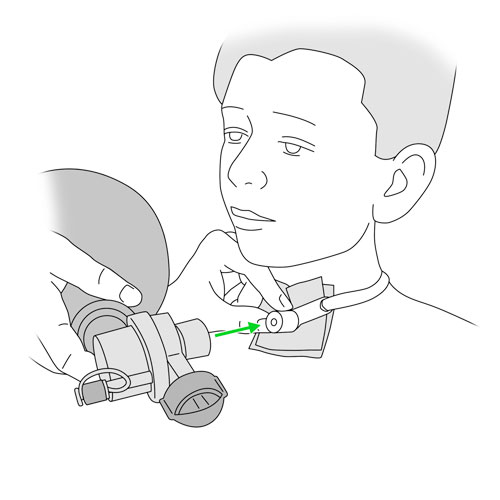Step 1: Anticipation

|
See the full description here
Summary:
Collaborate and form a team with your child. When you invest the time to form a strong team, children feel more comfortable and less anxious – this will help you complete the care with less stress – for you and your child.
Use these tips, from the start, to set the stage for a positive care procedure:
- Create the right moment: integrate the care in a routine.
- Alert your child to the needed care and communicate together.
- Form a team with your child: Encourage autonomy by offering realistic choices such as the method of distraction. Stay tuned to your child. Manage pain and anxiety, using distraction and positioning for comfort.
|
|
Step 2: Preparation

|
See the full description here
Summary:
- Prepare the environment: Identify a routine place for care. Close windows, doors and fans. Wash and dry the work surface and gather the needed materials for the care and to distract your child.
- Prepare your child: Get help if needed. Position your child for comfort to receive the care and start to use the selected distraction method.
- Prepare yourself: Find the right time when you are ready to provide the care safely. Review the list of care steps. Wash your hands.
Now that you are ready to start the care procedure, take the opportunity to encourage and praise your child.
|
|
Step 3: Procedure

|
See the full description here
Summary 3 key concepts:
- Safety: Carefully follow the care practice steps as you have been taught.
- Flexibility: Be ready to adjust according to your child’s reactions during the procedure. As needed, reposition or select an alternative distraction strategy. Follow your child’s pace and rhythm.
- Collaboration: Reassure your child, verbally and non-verbally. Acknowledge your child’s emotions and reactions. Help your child differentiate between the different sensations during a procedure.
|
|
Step 4: Prepare and verify the ventilatory bag

|
- Check that the bag, dead space and the tracheotomy adapter, if used, are in good condition (not damaged, cracked or dirty).
- Connect the dead space and the tracheostomy adapter to the air outlet of the ventilatory bag, if required.
- Make sure that the parts are well connected.
- Compress the bag with one hand and release it; at the same time check with your other hand to ensure that air is coming out of the bag at the air outlet. The bag should rapidly and automatically reinflate.
Why ? This step verifies that the bag is in good condition and functions correctly.
|
|
Step 5: Position your child

|
- Place your child in a comfortable position that allows you to easily access your child’s tracheal cannula to proceed with manual ventilation as required.
Why ? The best position is one which easily facilitates manual ventilation.
|
|
Step 6: Prepare your child

|
- Remove the speaking valve or the artificial nose, if present on the tracheal cannula.
- Disconnect the ventilation circuit from the tracheal cannula, if in place.
- Suction the secretions, if needed.
- Turn off the ventilatory assistance device, if it was on.
- Turn off the heated humidifier, if it was being used, by pressing the stop button.
Why ? This step disconnects the tracheal cannula from previously connected devices in order for the child to receive manual ventilation.
|
|
Step 7: Inflate the cuffed tracheal cannula, if applicable

|
If your child has a tracheal cannula without a cuff, or if the cuff is already inflated, then go to the next step.
- Fill the syringe with the amount of air specified by your healthcare team.
- Insert the tip of the syringe into the valve of the pilot balloon of the tracheal cannula, screwing it to connect securely.
- Slowly push the air into the cuff, 0.5 ml at a time.
- Once the cuff is inflated, detach the syringe by unscrewing it.
Why ? If your child uses a cuffed tracheal cannula, then this step helps to reduce air leaks and improves the effectiveness of ventilatory assistance.
|
|
Step 8: Connect the ventilatory bag to the tracheal cannula

|
- Hold the tracheostomy connector with one hand to stabilize it.
- With the other hand, connect the air outlet of the ventilatory bag (or the tracheostomy adapter, if present) to the tracheostomy connector.
Why ? This step secures the connections so that manual ventilation may take place.
A correct connection of ventilatory bag to the tracheostomy connector avoids air leaks during manual ventilation.
|
|
Step 9: Ventilate with the ventilatory bag

|
- With one or two hands, gently compress the air bag, so that your child’s chest rises as the lungs inflate.
- Release the bag and allow it to reinflate.
- Give your child time to breathe out; you should see your child’s chest lower as the lungs deflate.
- Make sure that the depth of the air compressions and the rate of breathing are in accordance to the recommendations of the healthcare team.
- Continue ventilation as long as necessary.
Why ? This step ensures the safety and effectiveness of manual ventilation.
As the bag does not have a device to measure the amount of air supplied, it is important to carefully monitor the rise and fall of your child’s chest to ensure that the lungs are filling and emptying adequately.
Tension on the tracheostomy connector may cause air leaks which will decrease the effectiveness of the ventilation.
Excess tension on the tracheal cannula may cause accidental decannulation.
|
|
Step 10: Disconnect the ventilatory bag from the tracheal cannula

|
Once the period of manual ventilation is finished:
- Hold the tracheostomy connector with one hand to stabilize it.
- With the other hand, disconnect air outlet of the ventilatory bag (or the tracheostomy adapter, if present) from the tracheostomy connector.
Why ? This step puts an end to the manual ventilation.
|
|
Step 11: Deflate the cuffed tracheal cannula, if applicable

|
If your child has a tracheal cannula without a cuff, if the cuff doesn’t need to be deflated or needs to be reconnected to the mechanical invasive ventilation, then go to the step 13.
- Before deflating the cuff, suction the secretions. Holding the syringe, push the plunger all the way in to remove any air.
- Insert the tip of the syringe into the valve of the pilot balloon of the tracheal cannula, screwing it to connect securely.
- Pull the plunger out slowly until you feel resistance.
- Verify that you have removed the volume of air that was injected into the cuff in step 7.
- Once the cuff is deflated, detach the syringe by unscrewing it.
Why ? Deflating the cuff allows the passage of air into the lungs via the nose and mouth, in addition to the tracheal cannula.
Aspirating the secretions before deflating the cuff prevents any accumulated secretions from going into the lungs.
|
|
Step 12: Replace the speaking valve or the artificial nose, if needed

|
- Suction the secretions, if needed.
- Replace the speaking valve or the artificial nose on the tracheal cannula, if needed.
Always ensure that the cuff of the tracheal cannula is deflated before putting the speaking valve in place.
Why ? This step replaces the devices in place prior to manual ventilation.
|
|
Step 13: Restart invasive ventilation, if needed

|
If your child does not require invasive ventilation, go the next step.
Why ? This step allows the child to be reconnected to mechanical invasive ventilation.
|
|
Step 14: Clean and store the equipment

|
- Do not immerse the bag in water.
- Clean and store the equipment according to the recommendations.
Why ? This step is required to prevent infections and to maintain the equipment in working order.
|
|
Step 15: Recovery

|
See the full description here
Summary:
The treatment is finished. Wash your hands again.
Be prepared to recognize the challenges faced and to provide positive feedback. Help your child recognize his/her strengths. Acknowledge the collaborative teamwork.
- Listen to what your child says about the parts of the procedure that were difficult or painful.
- Comfort your child and recognize your child’s collaboration with positive feedback.
- Highlight your child’s specific strengths that helped make the procedure positive.
- Discuss with your child what might be done the same or differently the next time the care is needed.
- Keep your promises if you have promised a reward, follow through.
- Reward yourself too.
|
|
![]()